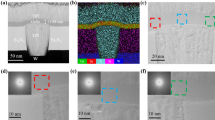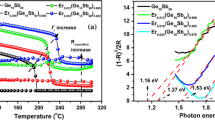Abstract
Phase-change memory is promising because it has a simple structure and has scalability that originates from its unique operating mechanism. However, the programming current should be reduced in accordance with the scaling of cell size [1,2]. We previously reported PCM (Phase Change Memory) cells that operate under 1.5-V/100-μA writing pulses [3, 4]. This PCM had a cell structure composed of 180-nm-W (tungsten) bottom contact to an O-GST (Oxygen-doped GeSbTe) film. Its low-power characteristic is suitable for 0.13-μm generation embedded applications. In the present study, we introduced a new W/O-GST/TaO/W cell structure and found further decrease of programming current the improved stability in the fabrication process. We analyzed the mechanism by which oxygen in GST and the additional TaO layer reduce the power consumption during SET/RESET operations.
Similar content being viewed by others
References
S. L. Cho et al., Symp. On VLSI Technology, pp. 96–97, 2005.
S. Lai, IEDM Tech. Dig., pp. 10.1.1– 10.1.4, 2003.
N. Matsuzaki et al., IEDM Tech. Dig., pp. 31.1.1–31.1.4, 2005.
Y. Matsui et al., IEDM Tech. Dig., pp. 30.1.1–30.1.4, 2006.
Author information
Authors and Affiliations
Rights and permissions
About this article
Cite this article
Fujisaki, Y., Matsuzaki, N., Kurotsuchi, K. et al. Energy Band States of an Oxygen-doped GeSbTe Phase-change Memory Cell; Mechanism of Low-voltage Operation. MRS Online Proceedings Library 997, 1101 (2007). https://doi.org/10.1557/PROC-0997-I11-01
Received:
Accepted:
Published:
DOI: https://doi.org/10.1557/PROC-0997-I11-01




